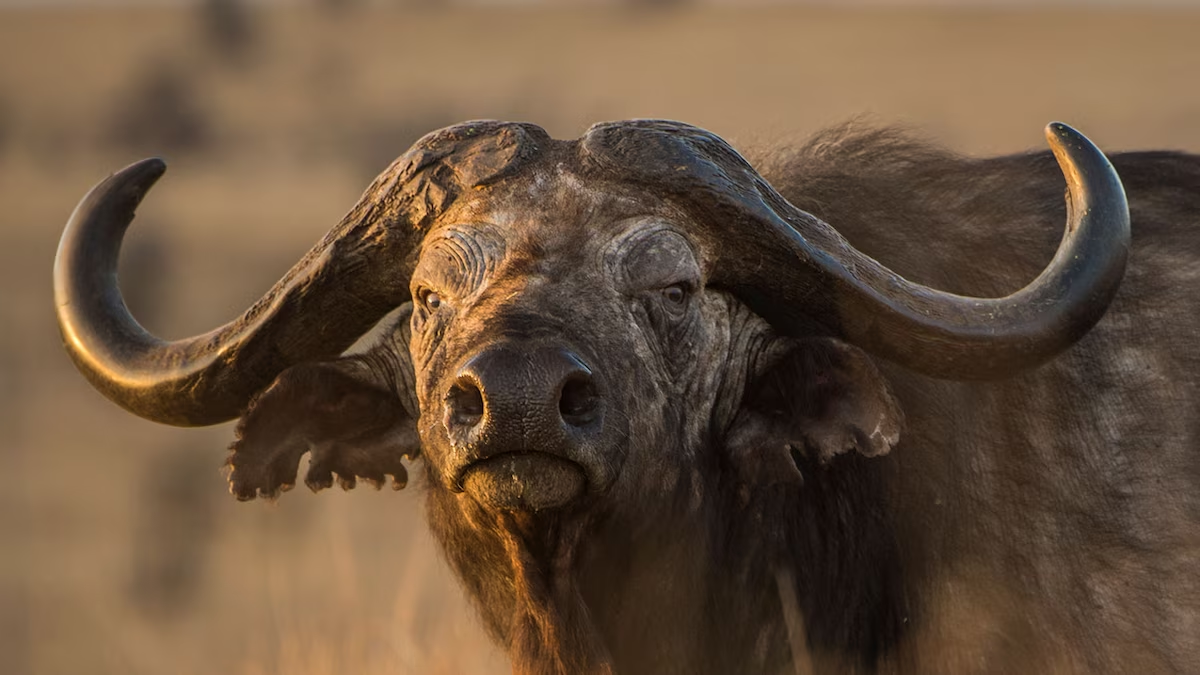Africa is a continent of vast landscapes, from golden savannas to dense jungles, arid deserts, and misty mountains.
It’s also home to some of the most iconic wildlife on Earth—and many of these animals wear horns like nature’s crown. These horned animals are not only visually striking, but also perfectly adapted for survival. From massive antelope herds to solitary desert dwellers, horns play a vital role in defense, dominance, and display.
Let’s take a look at some of the most fascinating African animals with horns, their unique adaptations, and the roles their horns play in the wild.
1. African Buffalo (Syncerus caffer)
The African buffalo, also known as the Cape buffalo, is one of the “Big Five” game animals and a symbol of power and resilience. With its deep-set eyes, muscular build, and broad, curving horns, the buffalo commands respect in the wild.
- Horns: Both males and females have horns, but the males’ are much larger. In mature males, the horn bases fuse into a thick shield known as a “boss.”
- Purpose: Horns are used to fight off predators like lions, establish dominance, and defend their herd.
Despite their stocky appearance, buffalo are agile and can be surprisingly aggressive when threatened.
2. Greater Kudu (Tragelaphus strepsiceros)
The greater kudu is one of the most elegant and iconic antelopes in Africa. Males are known for their long, spiraled horns, which can grow over 1.8 meters (6 feet) long.
- Horns: Only males have the spectacular spiraled horns.
- Purpose: Horns are used in ritualized battles during mating season and serve as a stunning visual to attract females.
Their gray-brown coats, white stripes, and majestic horns make them a favorite subject for wildlife photography and safari-goers.
3. Impala (Aepyceros melampus)
Often seen in large herds across African savannas, the impala is one of the most common—and graceful—antelopes.
- Horns: Only males have slender, lyre-shaped horns, which can reach up to 90 centimeters (35 inches) in length.
- Purpose: Used in dominance fights and territory defense.
Although they seem delicate, impalas are incredibly agile, capable of leaping up to 10 meters in a single bound, using their horns for defense when cornered.
4. Oryx (Genus: Oryx)
The oryx is a desert antelope adapted to the arid regions of East and Southern Africa. They’re strikingly marked with black-and-white faces and long, straight, spear-like horns.
- Horns: Both males and females have horns, often over a meter long.
- Purpose: Horns serve as formidable weapons against predators and in interspecies competition.
Oryx are so tough that they can survive in scorching deserts for weeks without water, deriving moisture from the plants they eat.
5. Eland (Taurotragus oryx)
The eland is Africa’s largest antelope. Despite their size—males can weigh up to 1,000 kg (2,200 lbs)—they are surprisingly agile and can even jump fences.
- Horns: Both sexes have twisted horns, although the males’ are thicker and more tightly spiraled.
- Purpose: Horns are used for combat and defense, and males use them to establish dominance during mating season.
Eland are also one of the few antelope species that have been partially domesticated for milk and meat in some regions.
6. Warthog (Phacochoerus africanus)
Warthogs might not look majestic, but their curved tusk-like horns (technically elongated canine teeth) are essential for survival.
- Horns (Tusks): Both males and females have them, with males developing larger upper tusks that curl outward and upward.
- Purpose: Used to dig, defend against predators, and fight rivals.
Despite their odd looks, warthogs are fast, clever, and highly adaptable.
7. Rhinoceros (Family: Rhinocerotidae)
Although not “horned” in the traditional antelope sense, African rhinos possess some of the most famous horns in the animal kingdom.
- Species in Africa: White rhino and black rhino.
- Horns: Composed of keratin (like human fingernails), not bone. Rhinos typically have two horns, with the front horn being longer.
- Purpose: Defense, digging for water, breaking branches, and dominance displays.
Rhino horns are tragically the target of illegal poaching, driving both species close to extinction.
8. Addax (Addax nasomaculatus)
Rare and critically endangered, the addax is a desert-dwelling antelope found mainly in the Sahara.
- Horns: Both sexes have long, twisted horns that form two to three elegant spirals.
- Purpose: Used in fights over mating rights and for defense.
Their pale coat reflects sunlight, and their hooves are specially adapted for walking on sand.
The Role of Horns in the Wild
Horns in African animals serve many purposes:
- Defense: From predators or rivals.
- Social status: Used in mating rituals and establishing dominance.
- Communication: Size and shape of horns can signal strength and fitness to mates.
- Tool use: Some species use their horns to dig or break vegetation.
What’s fascinating is the variety of shapes and sizes—from the graceful spirals of a kudu to the rugged bosses of a buffalo. Nature has sculpted each to fit the needs of its bearer.
Final Thoughts
Africa’s horned animals are more than just striking silhouettes on the savanna—they are survival specialists, cultural symbols, and keystones of the ecosystems they inhabit. Their horns tell stories of evolution, adaptation, and resilience.
But many of these species face increasing threats from habitat loss, climate change, and poaching. Conservation efforts are vital to ensure future generations can witness these animals in the wild, horns held high under the African sun.

